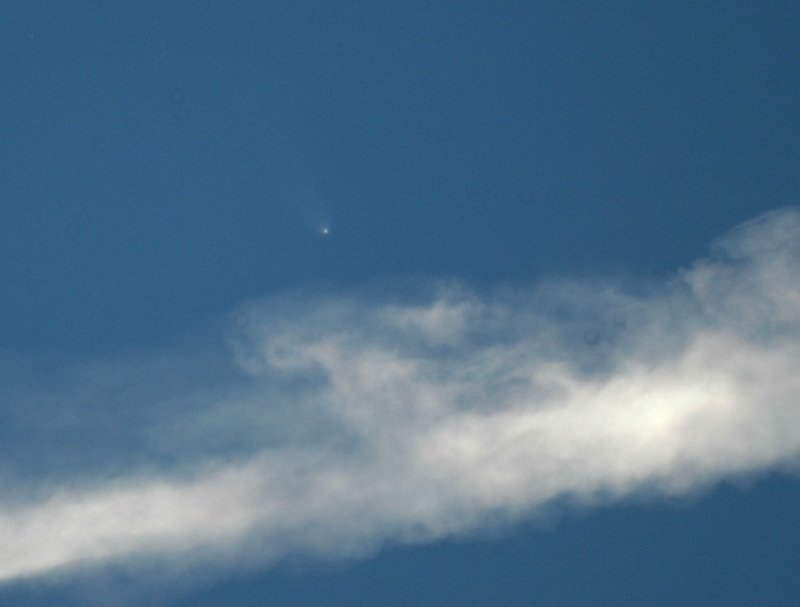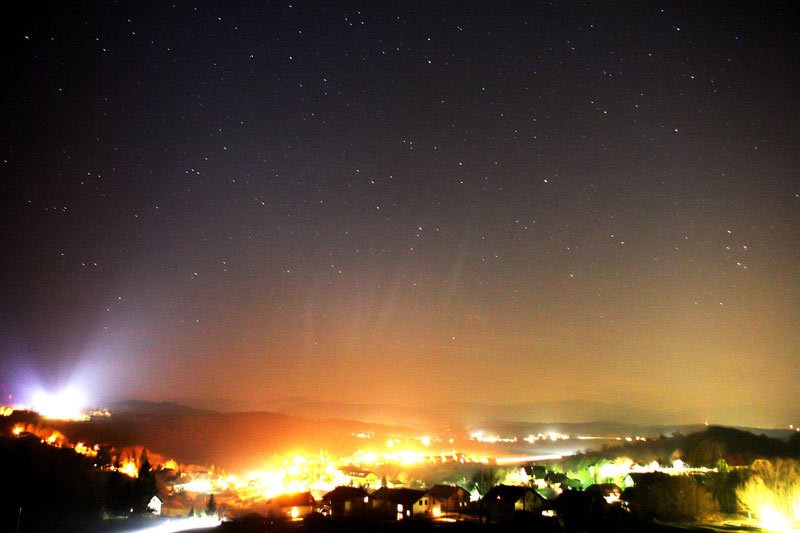January 08, 2007
Note that the image on this page is highly magnified. Some have recommended a 200mm focal length if shooting it with a 35mm camera. The tail may only be evident as the sky darkens (civil twilight ends about 30 minutes after sunset), but the longer you wait to pick it up, the lower to the horizon line it will be. Here is a more realistic picture of the comet, taken on Jan. 5th. The comet is visible in the space between the dark clouds to the far right of the image, just over half-way up. The exposure time given is 2 Seconds at 100 ISO, and was taken with a Canon Digital Rebel (100mm focal length). Some recommend using binoculars to locate it first, and then they are able to see it clearly with the naked eye (after knowing right where to look). This is nowhere near the class of Hyakutake or Hale/Bopp, but if you get a kick out of seeing things that most people don't even bother to take notice of, Comet McNaught is for you!
-
It's worth noting that for morning people, the comet is also visible in the E/SE, rising before the sun. I'd start looking 40 minutes before sunrise, which would give you about 10 minutes before civil twilight begins.
-
OK, I'm a nerd, but this is getting even cooler. Those of you who follow aurora (Northern Lights) threads may be familiar with SOHO LASCO C3. Here's what it looks like when a comet comes within its view, as happened to Comet Neat in 2003 (mpg video). Well stay tuned, because McNaught is expected to come through the viewframe in a matter of days. There is some talk of McNaught coming close enough to the sun to not survive the passage, but it is difficult to say because measurements of its core size have been difficult at best. Concensus is that this is McNaught's first trip around the sun, which could make it highly unpredictable. Some (overly?) optimistic estimates have it brightening to 40x the brightness of VENUS which could make it a daylight comet. NASA Java applet of McNaught's orbit. (You can clearly visualize why it appears so close to the sun right now, from the earth's line-of-sight). Bright New Comet Could Become Brilliant. (Great links in/after that article). Anyway you slice it, this is gonna be an interesting ride!
-
Stop, please, you're killing me. I'm trapped in a light-polluted city all week.
-
For comparison, here are the orbits of the Great Daylight Comet of 1910 the 1927 appearance of Comet Skjellerup-Maristany (which was seen in daylight 5 degrees from the sun and later in the month displayed a tail 40 degrees long).
-
Tough crowd. : )
-
Thanks for the post mecurious. Not sure if I'll have much of a view of this part of the sky - - but I'll definitely give it a look-see. *ooohs and aaahhhs*
-
via Yes, that is a joke.
-
Let's hope the pollution here lets me see this. Thanks for the heads-up (ho ho) mercurious.
-
Is the mothership coming, too?
-
I just love comets. I hope it's clear this weekend when I'll be somewhere dark.
-
Great. Now I'm hungry for Comet McNuggets.
-
No commet. awaits quid's sommet
-
This is a great post, mecurious. Alas, I seem to have 20+ metres of cloud cover to contend with.
-
Spaceweather.com has started a multipage gallery of Comet McNaught, taken by people around the world. Northern hemisphere viewers should get a glimpse in the next couple of days. Then switch to SOHO for the online show. When it emerges from the sun's glare (later in the month) it will be a wonderful sight for the Southern Hemisphere. If anyone would like to buy me an airline ticket to Australia, I'd be forever grateful. : )
-
Il Posto Beautissimo mecurious! I will hopefully be tuning in tune night. But is it all for McNaught?? Ha! Haa! Didja see what I did there?
-
Any monkeys in the Melbourne area? I'd give my right trolley to be there later in the month. A 1/2 day's drive west out the Great Ocean Road and the view to the W/SW could include this: http://i1.trekearth.com/photos/35662/id13038-1138187405.jpg Now imagine it with a Great Comet in the sky trailing a 30-40 degree tail. After it rounds the sun it will be viewable in the Southern Sky (as in hemisphere). Here's a sky map for New South Wales: http://i1.trekearth.com/photos/35662/id13038-1138187405.jpg on the discoverer's page: http://msowww.anu.edu.au/~rmn/C2006P1.htm
-
Oops, here is the corrected link to the skymap for NSW: http://msowww.anu.edu.au/~rmn/P1diag.jpg
-
Bummer, it looks like it's just barely out of visibility in NZ.
-
Not to worry. The show shifts to the southern hemisphere in the latter half of January.
-
Saw it myself last night, but blew my photo opportunity. Tonight was cloudy (and probably my last chance with bad weather moving in). HOWEVER, here is an excellent time-lapse of what we missed tonight by Charleston, West Virginia stormchaser chaser Dan Robinson : http://wvlightning.com/2007/jan10.wmv Enjoy!
-
there
-
Dang. http://wvlightning.com/2007/jan10.wmv there!
-
Saw it last night over Dow's Lake in Ottawa on my walk home from work -- fantastic. I wasn't expecting it to be that bright. You could see the tail pretty clearly.
-
Photography: how to light a comet
-
Hi mercurious! I'm in Melbourne. I've got a week's holiday booked, and the only thing planned is some boozing in SA. We were trying to decide between the Great Ocean Road and more boozing in the Yarra Valley. Thanks for the suggestion! Decision made.
-
And you didn't take me with you?!? **buries head in arms and sobs like a baby** **looks up to see if anyone has bought him an airline ticket to Melbourne yet**
-
Comet McNaught is now visible in broad daylight. "It's fantastic," reports Wayne Winch of Bishop, California. "I put the sun behind a neighbor's house to block the glare and the comet popped right into view. You can even see the tail!" Just hours ago, Mark Vornhusen took this picture of the comet between clouds over Gais, Switzerland:
 The secret to seeing McNaught: Get rid of the sun. You can do this by standing in the shadow of a tall building or billboard. Make a fist and hold it at arm's length. The comet is about one fist-width (5 degrees) east of the sun's position. Try it!
Warning: Binoculars dramatically improve the view of the comet, allowing you to see structure within the tail . But please be super-careful not to look at the sun. Direct sunlight through binoculars can cause permanent eye damage.
via spaceweather.com
Map for the west horizon after sundown starting TOMORROW NIGHT from SE Australia:
The secret to seeing McNaught: Get rid of the sun. You can do this by standing in the shadow of a tall building or billboard. Make a fist and hold it at arm's length. The comet is about one fist-width (5 degrees) east of the sun's position. Try it!
Warning: Binoculars dramatically improve the view of the comet, allowing you to see structure within the tail . But please be super-careful not to look at the sun. Direct sunlight through binoculars can cause permanent eye damage.
via spaceweather.com
Map for the west horizon after sundown starting TOMORROW NIGHT from SE Australia:
 And for New Zealand:
http://www.scoop.co.nz/stories/SC0701/S00023.htm
And for New Zealand:
http://www.scoop.co.nz/stories/SC0701/S00023.htm
-
Woo! *crosses fingers for proper summer and clear skies*
-
Great, I'll have a look tonight (it's the 14th here).
-
APOD Piccy!
-
*jealous of the kiwi view*
-
*still waiting for a clear view of the horizon*
-
*got a sky full of cloud*
-
Oh my God. McNaught's tail is becoming phenomenal (as seen from New Zealand/Austrailia/South Africa). In fact, there is a chance of photographing the TAIL from the northern hemisphere! Here it is from Slovenia:
 You need a DARK northern hemisphere sky to see/photograph it. 1 hour to 2 hours after sunset is a range that I have seen.
You need a DARK northern hemisphere sky to see/photograph it. 1 hour to 2 hours after sunset is a range that I have seen.